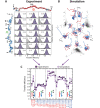FRET-based dynamic structural biology: Challenges, perspectives and an appeal for open-science practices
- PMID: 33779550
- PMCID: PMC8007216
- DOI: 10.7554/eLife.60416
FRET-based dynamic structural biology: Challenges, perspectives and an appeal for open-science practices
Abstract
Single-molecule FRET (smFRET) has become a mainstream technique for studying biomolecular structural dynamics. The rapid and wide adoption of smFRET experiments by an ever-increasing number of groups has generated significant progress in sample preparation, measurement procedures, data analysis, algorithms and documentation. Several labs that employ smFRET approaches have joined forces to inform the smFRET community about streamlining how to perform experiments and analyze results for obtaining quantitative information on biomolecular structure and dynamics. The recent efforts include blind tests to assess the accuracy and the precision of smFRET experiments among different labs using various procedures. These multi-lab studies have led to the development of smFRET procedures and documentation, which are important when submitting entries into the archiving system for integrative structure models, PDB-Dev. This position paper describes the current 'state of the art' from different perspectives, points to unresolved methodological issues for quantitative structural studies, provides a set of 'soft recommendations' about which an emerging consensus exists, and lists openly available resources for newcomers and seasoned practitioners. To make further progress, we strongly encourage 'open science' practices.
Keywords: FRET; biochemistry; biomolecules; chemical biology; community; conformation; dynamics; molecular biophysics; single-molecule; structural biology.
Conflict of interest statement
EL, AB, JH, BA, VB, SB, RB, HS, TC, TC, AD, JD, JF, RG, IG, TH, CH, GH, NH, SH, SH, TH, AI, CJ, AK, HK, TL, NL, TL, EL, EM, JM, XM, SM, DN, TP, EP, YR, NR, BS, HS, CT, RV, DL, CS, SW No competing interests declared
Figures









References
Publication types
MeSH terms
Grants and funding
- C14/16/053/KU Leuven Special Research Fund
- SMPFv2.0/ERC_/European Research Council/International
- 819299/ERC_/European Research Council/International
- R01 GM123164/GM/NIGMS NIH HHS/United States
- NNF14CC0001/Novo Nordisk
- 3565/20/Israel Science Foundation
- CIBSS - EXC-2189 - project ID 390939984/Deutsche Forschungsgemeinschaft
- GM079238/NH/NIH HHS/United States
- GM130793/NH/NIH HHS/United States
- R01 GM112882/GM/NIGMS NIH HHS/United States
- 1818147/National Science Foundation
- SPP2191 402723784/Deutsche Forschungsgemeinschaft
- RGF\R1\180054/Royal Society
- R01 GM098859/GM/NIGMS NIH HHS/United States
- GM084288/NH/NIH HHS/United States
- NRF-2019R1A2C2005209/National Research Foundation of Korea
- 128185/NH/NIH HHS/United States
- R01 GM130942/GM/NIGMS NIH HHS/United States
- DP2 GM128185/GM/NIGMS NIH HHS/United States
- R01 GM095904/GM/NIGMS NIH HHS/United States
- 110164/Z/15/Z/WT_/Wellcome Trust/United Kingdom
- R01 GM130793/GM/NIGMS NIH HHS/United States
- SFB 1129 240245660/Deutsche Forschungsgemeinschaft
- BB/T008032/1/BB_/Biotechnology and Biological Sciences Research Council/United Kingdom
- 638536/ERC_/European Research Council/International
- 1842951/National Science Foundation
- GM130375/NH/NIH HHS/United States
- DKR00620/Royal Society
- GM137608/NH/NIH HHS/United States
- CF16-0797/Carlsbergfondet
- RGS\R2\180405/Royal Society
- 2019R1A2C2090896/National Research Foundation of Korea
- R01 GM084288/GM/NIGMS NIH HHS/United States
- PL696/4-1/Deutsche Forschungsgemeinschaft
- SFB1035/Deutsche Forschungsgemeinschaft
- ANR-17-CE09-0026-02/Agence Nationale de la Recherche
- GM095904/NH/NIH HHS/United States
- 1250/19/Israel Science Foundation
- SE 1195/21-1 (SPP 2191)/Deutsche Forschungsgemeinschaft
- NRF-2019R1A2C1089808/National Research Foundation of Korea
- WT_/Wellcome Trust/United Kingdom
- SFB863/Deutsche Forschungsgemeinschaft
- 2018YFA0507700/National Key Research and Development Program of China
- GRK2062/Deutsche Forschungsgemeinschaft
- 671208/ERC_/European Research Council/International
- RGP0061/2019/Human Frontier Science Program
- R35 GM130375/GM/NIGMS NIH HHS/United States
- ANR-18-CE11-0004-02/Agence Nationale de la Recherche
- GM130942/NH/NIH HHS/United States
- R01 GM137608/GM/NIGMS NIH HHS/United States
- 2004016/National Science Foundation
- R-10789/UHasselt BOF fund
- R01 GM140272/GM/NIGMS NIH HHS/United States
- ANR-19-CE44-0009-02/Agence Nationale de la Recherche
- BB/S008896/1/BB_/Biotechnology and Biological Sciences Research Council/United Kingdom
- 860954/ERC_/European Research Council/International
- 18333/Villum Fonden
- R01 GM079238/GM/NIGMS NIH HHS/United States
- 6110-00623B/Independent Fund Denmark
LinkOut - more resources
Full Text Sources
Other Literature Sources
Miscellaneous

